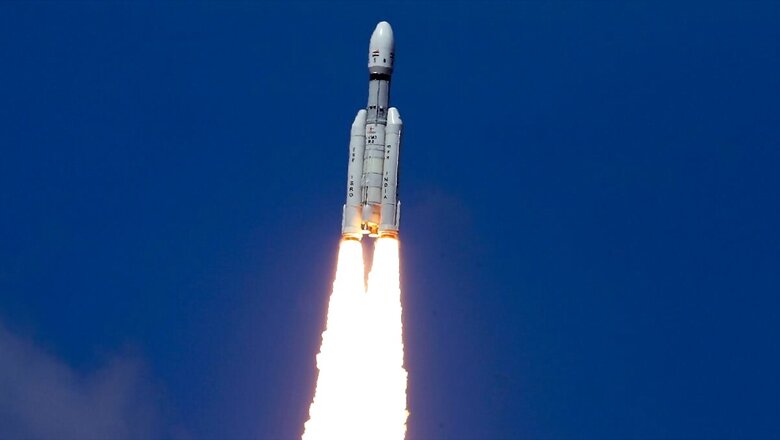
views
India’s ambitious Chandrayaan-3 spacecraft lifted off on Friday afternoon on its powerful new launch vehicle, Launch Vehicle Mark-III or LMV3, from the Satish Dhawan Space Centre in Sriharikota. The spacecraft is likely to touch down on the moon’s surface on August 23. Despite a small budget, ISRO has produced effective missions without compromising the quality of its resources and supplies.
With this mission to the moon, India has cemented its position in space exploration — from the successful Mars Mission to the sun mission, Gaganyaan. As India plans big space projects in the coming years, the budget for the department of space (DoS), valuation of space launches and the number of private players in space technology has become even more important for the funding of ISRO projects.
In the current fiscal, the space industry received a decreased amount than previous years but funding for the space department has recorded a significant rise in the last five years. The budget allocated for DoS was Rs 12,543 crore for FY 2023-24, Rs 13,700 crore for FY 2022-23, Rs 13,950 crore for FY 2021-22 (highest in the last five years), Rs 13,480 crore for FY 2020-21 and Rs 12,470 crore for FY 2019-20.
The expenditure for some of the most significant ISRO projects, such as missions to reach Mars and the moon in the last 10 years, demonstrate how the space agency has effectively used resources to launch missions. For example, India’s first interplanetary Mars orbiter programme — Mission Mangalyaan — was launched on November 5, 2013, at a budget of Rs 450 crore. It is the world’s cheapest Mars Mission so far.
The GSLV MkIII-M1 from Sriharikota successfully launched the Chandrayaan-2 mission on July 22, 2019, at a cost of Rs 978 crore, including Rs 603 crore for the orbiter, lander, rover, navigation and ground support network and Rs 375 crore for the heavy GSLV rocket with indigenous cryogenic engine. Chandrayaan-3 is made with a lower budget than Chandrayaan-2, costing around Rs 615 crore including all elements.
India will be the fourth country to land on the moon’s surface after the US, Russia and China. But India will be the first country, which is reaching the moon at the lowest budget as compared to the three other countries. Estimates show that the US spent $25 billion on the moon mission — 15 Apollo mission — which would have cost over $100 billion now. According to a report by the Organisation for Economic Cooperation and Development (OECD), China spent $8.4 billion on its space programme, the Chang’e 4 Lunar Craft and the Asian Giant. Russia spent $20 billion in 1966 on an unmanned moon craft.
How ISRO manages to spend less
- Low labour expenses and infra costs: As compared to NASA and other international space agencies, ISRO has been able to control expenditures through reduced cost of hiring talent in India.
- Supply of critical material from major private aerospace companies at cheaper prices: Godrej Aerospace, a Mumbai-based private aerospace company provided essential components to ISRO and made significant contributions to the projects, including Chandrayaan-1, Chandrayaan-2, and Mangalyaan. For Chandrayaan-1, they provided the Vikas engine, satellite thrusters, critical parts for remote sensing and ground system antenna. They provided the GSLV Mk III launcher’s L110 and CE20 engines, as well as the orbiter’s and lander’s thrusters and the DSN antenna’s components for Chandrayaan-2, being carried by Chandrayaan-3 as well. Maneck Behramkamdin, assistant vice-president and business head, Godrej Aerospace, said, “The collaboration began with the production of critical components to meet ISRO’s needs, and then expanded to liquid propulsion engines.”
- International collaborations with NASA, other space agencies: “Chandrayaan-1 has been an example of international cooperation with its international payloads. It has also earned several national and international laurels and was instrumental in the ISRO-NASA joint discovery of water molecules on the moon surface, unattained by any of the previous missions of such nature,” ISRO stated. It added: “ISRO and NASA are realising a joint satellite mission called NISAR (NASA ISRO Synthetic Aperture Radar) for earth science studies. As part of the Indo-French cooperation, ISRO and CNES have completed the feasibility study on realising an earth observation satellite mission with thermal infrared imager, named as TRISHNA. ISRO and JAXA scientists are conducting the feasibility study to realise a joint satellite mission to explore the moon’s polar region.” Former ISRO scientist Nambi Narayanan told CNN-News18 about ISRO’s next collaboration with Japan and said it was good to have collaborations for glory as well as investment opportunities.
- Commercial trade: Over the past few years, ISRO has generated a substantial revenue through its commercial trade. According to information provided by union minister Jitendra Singh, the agency launched missions for numerous private and foreign agencies, generating revenue of about Rs 288 crore between 2019 and 2021.




















Comments
0 comment